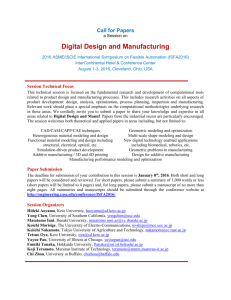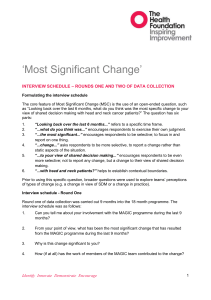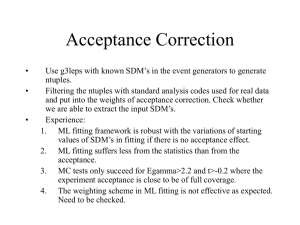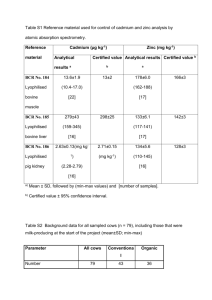SDM is a stage for discovering new self
advertisement
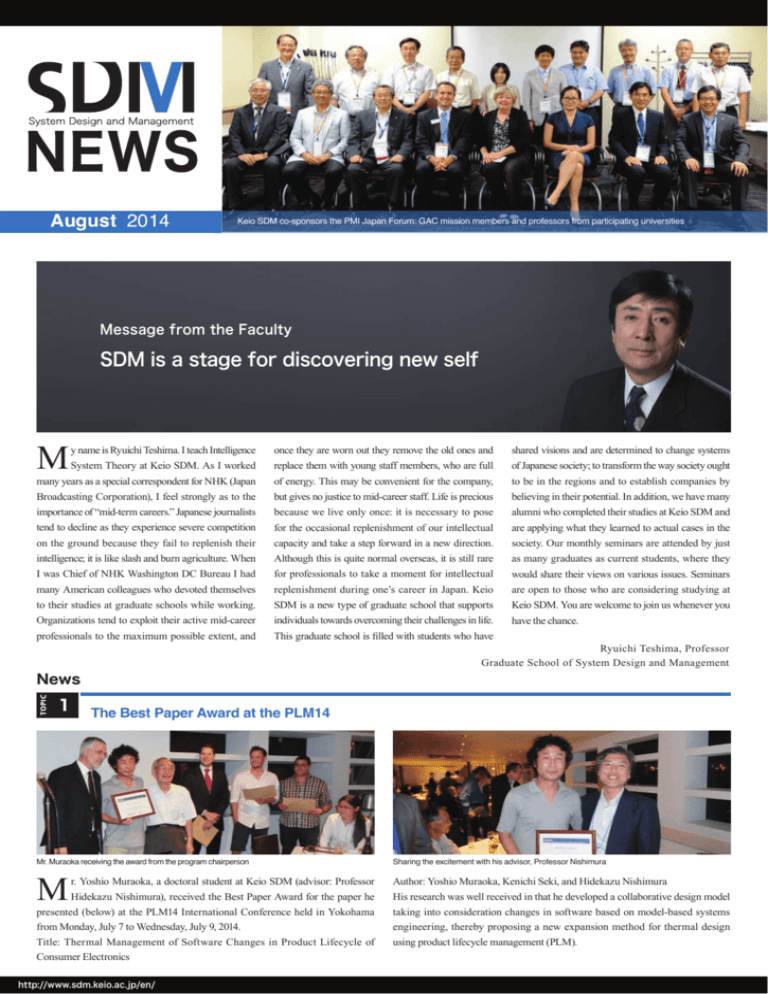
August 2014 Keio SDM co-sponsors the PMI Japan Forum: GAC mission members and professors from participating universities Message from the Faculty SDM is a stage for discovering new self M y name is Ryuichi Teshima. I teach Intelligence once they are worn out they remove the old ones and shared visions and are determined to change systems System Theory at Keio SDM. As I worked replace them with young staff members, who are full of Japanese society; to transform the way society ought many years as a special correspondent for NHK (Japan of energy. This may be convenient for the company, to be in the regions and to establish companies by Broadcasting Corporation), I feel strongly as to the but gives no justice to mid-career staff. Life is precious believing in their potential. In addition, we have many importance of “mid-term careers.” Japanese journalists because we live only once: it is necessary to pose alumni who completed their studies at Keio SDM and tend to decline as they experience severe competition for the occasional replenishment of our intellectual are applying what they learned to actual cases in the on the ground because they fail to replenish their capacity and take a step forward in a new direction. society. Our monthly seminars are attended by just intelligence; it is like slash and burn agriculture. When Although this is quite normal overseas, it is still rare as many graduates as current students, where they I was Chief of NHK Washington DC Bureau I had for professionals to take a moment for intellectual would share their views on various issues. Seminars many American colleagues who devoted themselves replenishment during one’s career in Japan. Keio are open to those who are considering studying at to their studies at graduate schools while working. SDM is a new type of graduate school that supports Keio SDM. You are welcome to join us whenever you Organizations tend to exploit their active mid-career individuals towards overcoming their challenges in life. have the chance. professionals to the maximum possible extent, and This graduate school is filled with students who have Ryuichi Teshima, Professor Graduate School of System Design and Management News 1 The Best Paper Award at the PLM14 Mr. Muraoka receiving the award from the program chairperson Sharing the excitement with his advisor, Professor Nishimura r. Yoshio Muraoka, a doctoral student at Keio SDM (advisor: Professor Hidekazu Nishimura), received the Best Paper Award for the paper he presented (below) at the PLM14 International Conference held in Yokohama from Monday, July 7 to Wednesday, July 9, 2014. Title: Thermal Management of Software Changes in Product Lifecycle of Consumer Electronics Author: Yoshio Muraoka, Kenichi Seki, and Hidekazu Nishimura His research was well received in that he developed a collaborative design model taking into consideration changes in software based on model-based systems engineering, thereby proposing a new expansion method for thermal design using product lifecycle management (PLM). M http://www.sdm.keio.ac.jp/en/ SDM NEWS August 2014 2 Keio SDM Co-Sponsors PMI Japan Forum from Sat, July 12 to Sunday, July 13, 2014 The venue for the Academic Track was packed K Associate Professor Toma lecturing at the workshop 3 On eio SDM, being the academic sponsor for the Project Management Institute (PMI) Japan Chapter, co-sponsored the largest event organized by PMI Japan Chapter, “PMI Japan Forum,” which was held in Tokyo across two days on Saturday, July 12 and Sunday, July 13, 2014. Keio SDM Associate Professor Tetsuya Toma (director of PMI Japan Chapter) attended the “GAC Workshop” (university professionals only) and “Academic Track”. At the GAC workshop he introduced Keio SDM’s human resource development initiatives. The GAC stands for Global Accreditation Center for Project Management Education Programs; it ensures education quality by accrediting education institutions to which PMI headquarters (US) provides higher education in project management. While there are 45 GAC-accredited institutions globally (as of the end of 2013), no Japanese universities have been accredited thus far. This time, three professionals visited Japan from PMI-GAC and had the opportunity to deepen their understanding of the status of Japanese project management education. They also discussed the possibility of accrediting Japanese institutions, according to which Keio SDM is indeed one of the candidates for accreditation in the near future. In the Academic Track group, in addition to the presentations of various research findings a panel discussion was held to facilitate discussion between the business industry and universities. The forum was useful in that it provided a platform for the business industry and universities to discuss issues such as human resource development by the universities and the types of human resources required by the business industry. The Opening of Keio SDM Obuse Social Design Center Thursday, July 10, 2014, a forum was held to celebrate the opening of the Keio SDM Obuse Social Design Center (office name: Obuse Office, Social Design Center, SDM Research Institute) inside the municipal office of Obuse Town. COLUMN More than 100 people gathered from and outside Obuse Town for an orientation of the center and a panel discussion. Working creatively with various stakeholders, the center plans to organize Obuse youth meetings, an Obuse summer school, and future Obuse meetings, field trips for the Agricultural Laboratory and the Regional Development and Vitalization Laboratory while carrying out practical research for creating new businesses and developing a happy community. Stay tuned! The Visible Light Communications Association commences its activities in May 2014 S ince the Visible Light Communications Consortium was voluntarily formed by Keio and others in November 2003, we have been disseminating, advocating, planning and promoting the standardization of visible light communications for over ten years. Today LED visible light is widely used, such as for lighting, traffic lights and car lamps, and it is increasingly demanded that businesses are created using visible light communication technologies. In response to such a situation, the Visible Light Communications Consortium, a voluntary group, was upgraded to the Visible Light Communications Association (VLCA) in May 2014. VLCA aims to provide a foundation and platform for visible light communications and to disseminate visible light communications http://www.sdm.keio.ac.jp/en/ widely in society as a social infrastructure; it began its activities with Keio SDM Professor Haruyama as the chairperson. The main activities of the newly established VLCA are as follows: ● Establishing the foundation of visible light ID ● A project for formulating standards for visible light communications ● A project for examination on visible light communications standards ● Organizing events related to visible light communications ● Activities to promote visible light communications for market expansion For more information, please contact VLCA (Email: info@vlca.jp, Tel: 050-6867-3384) SDM NEWS August 2014 Laboratory / Center profile The Local Resource Utilization Laboratory Representative: Associate Professor Tetsuya Toma, Guest Professor Atsuo Yoshida, Professor Ryuichi Teshima Overview J Guest Professor Atsuo Yoshida, the co-representative of the laboratory apan is rich in marine and forest resources. The country has 3,500km of coastline in the northto-south direction, and 68% of the country (a total area of 380,000m2) is covered by forest. In particular, the hilly and mountainous areas, between the outer plains and the mountains, have been contributing not only in terms of agricultural production but also as a rich source of energies including timbers and charcoals. The hilly and mountainous areas, therefore, have established a culture strongly connected to nature. The Local Resource Utilization Laboratory identifies agricultural, mountain and fishing villages full of natural resources and environment, including the above-mentioned hilly and mountainous areas, as the country’s frontier for the new lifestyles of the 21st century. The laboratory conducts research in pursuit of the ways in which these areas, together with local companies, could become proudly self-sufficient through collaboration with neighboring small-to-medium towns. The co-representative of the laboratory, Guest Professor Atsuo Yoshida (CEO of Yoshida Atsuo Accounting Office, licensed tax accountant), has been identified as one of the “institutions supporting business innovation” by the Ministry of Economy, Trade and Industry, and assists the problemsolving efforts of small and medium companies, while working as a member of the Boards of Certification for “Movable Assets Evaluation Advisors” in collaboration with financial institutions in order to promote asset-based lending (ABL), which the Financial Services Agency and the Bank of Japan are promoting. The Local Self-Reliance Economic Establishment Project S mall and medium companies constitute 99.7% of Japan’s businesses. While issues concerning management are becoming diverse and complex for small and medium companies, it is difficult for them to address most of the managerial issues A Seminar of the Local Resource Utilization Laboratory (at the Yoshida Astuo Accounting Office) because they lack human and physical resources. In particular, the reality of countryside is such that managerial issues are not well captured and that there are no bodies to assist companies faced with problems. We attempt to capture the characteristics of each locality in the country from a historical viewpoint, recognize the excellent resources that each locality historically embraces (e.g., agricultural fishing industry, traditional technologies and humanity nurtured by natural environment) and establish industries by leveraging on qualities that are unique to the locality. In so doing we collaborate with city governments, commercial and industrial associations, corporation associations, local shopping streets, local financial institutions and universities with a view to promoting measures that are based on the present situation and understanding of managerial issues. Fieldwork C ollaborating with the Policy Realization Division inside the Mayor’s Office of the Government of Hanno City, the laboratory works toward promoting the city. We will advocate technologies for woody biomass from upstream operations (logging, collection and transportation) to midstream (accumulation and energy conversion) and downstream operations (business generation and energy utilization). We also plan to support efforts toward sixth sector industrialization, which effectively utilizes regional resources that are originally from Hanno. Additionally, in collaboration with small-to-medium companies and agriculture/forestry businesses, we will pursue the development of new projects, new products and the commercialization of new services, while liaising with the Bureau of Economy, Trade and Industry and the Small and Medium Enterprise Agency. Systems Modeling Language, SysML “T he Model Based Systems Engineering (MBSE) is systems engineering.” The author of A Practical Guide to SysML (The MK/OMG Press), Mr. Sanford Friedenthal, would often say this at the International Council on Systems Engineering (INCOSE) and Object Management Group (OMG) meetings. The base for MBSE is systems engineering which is used to develop products and services. However, while conventional systems engineering was based on documents, Systems Modeling Language, SysML (translated version of A Practical Guide to SysML) Hidekazu Nishimura (supervisor of translation), Translators: Seiko Shirasaka, Terumasa Narukawa, Akihiro Hasegawa, Yusei Nakajima and Chih-Chiang Weng Original Author: Sanford Friedenthal, Alan Moore, Rick Steiner Publisher: Tokyo Denki University Press May 10, 2012 MBSE bases itself on models. This way, smoother multi-domain communications, more efficient (former IBM staff) and Professor Hidekazu Nishimura). The publication production with model re-utilization and better traceability of requirements can be expected. In introduced below is a translated version of a book titled A Practical Guide to recent years, the importance and necessity of MBSE has been increasingly acknowledged not only SysML (The MK/OMG Press), which was published around the time Keio in the aviation and space sector but also in industries such as automobiles and medicine. In particular, SDM began its lecture on MBSE in Fall 2008. The book is suitable for those Systems Modeling Language (SysML) is gaining attention as a means of expressing system models. who want to deepen their understanding of systems engineering and MBSE, Models using SysML can express behaviors, structures, requirements and parametric constraints, for researchers and technical professionals dealing with multi-domain system depicting systems from various views during the course of system engineering process. Keio SDM, developing such as mechanical, electronic and software, and for business since its foundation in 2008, has been teaching MBSE using SysML (lecturers: Mr. Laurent Balmelli managers who are considering introducing MBSE. SDM Research Institute, Graduate School of System Design and Management at Keio University Collaboration Complex, Keio University, 4-1-1 Hiyoshi, Kohoku-ku, Yokohama, Kanagawa 223-8526 Tel:045-564-2518 Fax:045-562-3502 E-mail:sdm@info.keio.ac.jp http://www.sdm.keio.ac.jp/en/
